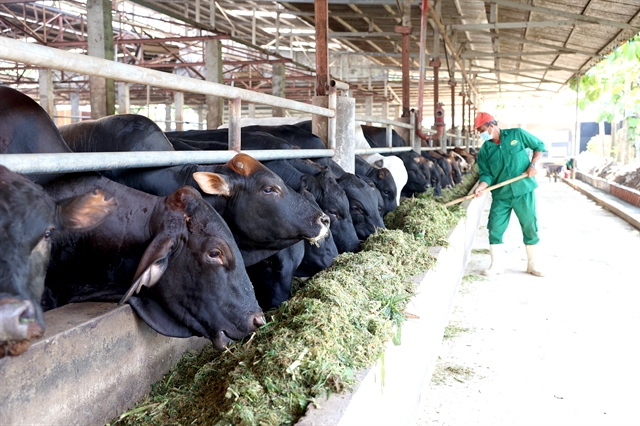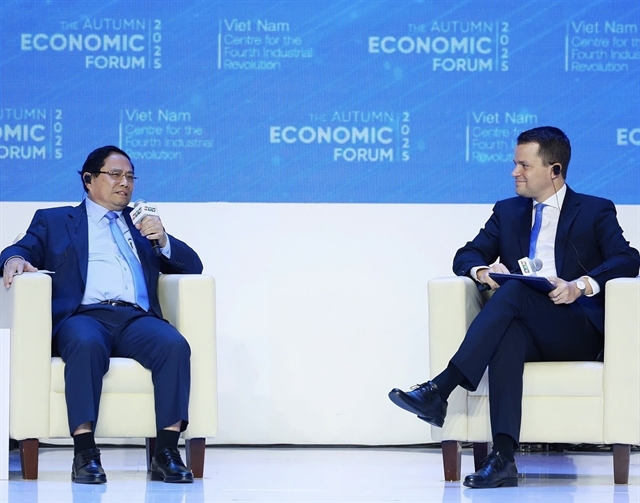 Society
Society

 |
| A worker feeds cattle at PACOW International Co., Ltd. in Trảng Bàng Town, Tây Ninh Province. The company has invested in developing a fully closed production chain “from farm to table,” ensuring meat quality that meets international standards. VNA/VNS Photo Thanh Tân |
HÀ NỘI — The Ministry of Agriculture and Environment has affirmed that reducing production costs and restructuring livestock herds in line with market demand are two urgent priorities for Việt Nam’s livestock sector.
The goal is to ensure a stable domestic meat supply while enhancing the competitiveness of export products.
The message was delivered at a forum held in Hà Nội on Tuesday to discuss solutions for lowering livestock production costs and stabilising meat supply for both domestic consumption and export.
The event was co-organised by Nông nghiệp và Môi trường (Agriculture and Environment) Newspaper in collaboration with the Ministry’s Department of Animal Husbandry and Veterinary Medicine and the Hà Nội Department of Agriculture and Environment.
The forum aimed to bring together policymakers, experts and businesses to propose practical solutions to overcome current challenges, apply scientific and technological advances and promote value chain linkages towards sustainable and efficient livestock development.
According to Đỗ Văn Hoan, Deputy Head of the Department of Animal Husbandry and Veterinary Medicine’s Livestock Breeding Division, between 2020 and 2024, Việt Nam’s pig population increased from nearly 25.8 million to over 32 million, while pork output reached 5.18 million tonnes, reaching average annual growth rates of 4.4 per cent and 5.3 per cent, respectively.
During the same period, the poultry population rose from 512.7 million to 584.4 million birds, with meat output reaching 2.46 million tonnes and egg production climbing to 20.44 billion, growing by 3.3–5.1 per cent annually.
Hoan noted that the livestock industry has actively adopted advances in science and technology, especially biotechnology and Industry 4.0 technologies, in breeding, selection and genetic management. Efforts to preserve and develop indigenous genetic resources have also been strengthened, helping to improve domestic breeds quality.
However, he pointed out that most breeding and selection processes still rely heavily on traditional methods, with limited information-sharing systems. The use of high technology in genetic evaluation and strain selection remains modest.
Representing the organisers, Lê Trọng Đảm, Deputy Editor-in-Chief of Nông nghiệp và Môi trường Newspaper, emphasised that livestock producers currently face many challenges related to output costs.
Input costs, particularly feed, which accounts for 65–70 per cent of total expenses, have risen sharply, making Vietnamese meat products more expensive than regional competitors and allowing imported products to penetrate the domestic market.
In addition, livestock production remains fragmented and small-scale. Many farmers have yet to reach medium or large-scale production or effectively apply technology in management, feed formulation or waste treatment.
He added that weak value chain linkages and rising demands for quarantine, biosecurity and environmental sanitation have further increased costs, especially for smallholder farmers.
At the forum, several businesses presented practical models and solutions.
Nguyễn Như Phán, Deputy Director of Dabaco Chicken Breeding Co. Ltd, said reducing antibiotic use and strengthening disease prevention through vaccines, creating near-natural environments and establishing biosecurity buffer zones inside and outside livestock houses are crucial measures to cut costs and improve productivity.
He stressed that nutritional management should be based on animals’ actual needs at each stage and environmental condition, providing nutrients “as needed, in the right amount, at the right time.”
This approach, he said, enhances nutrient absorption, reduces waste and odour and strengthens animals’ natural immunity while minimising intestinal and respiratory diseases.
Trần Huy Hoạt, Deputy Director of Amavet Veterinary Medicine JSC, introduced a “contactless livestock farming” model that minimises human-animal contact to prevent cross-contamination and improve biosecurity.
From feeding and cleaning to vaccination and treatment, every step follows strict disinfection and control protocols. For pig farming, workers must disinfect hands, boots and corridors before entry and avoid direct contact when feeding or vaccinating animals.
“This model not only protects livestock health but also reduces medical costs, increases productivity and improves economic efficiency,” Hoạt said.
Hoạt underlined that lowering production costs and ensuring a stable meat supply towards the end of 2025 are particularly important, given the surge in demand during the Tết (Lunar New Year) holiday.
If supply becomes unstable, price fluctuations could fuel inflation and affect people’s living standards. Therefore, cost reduction must go hand in hand with rational herd restructuring aligned with market signals to avoid overexpansion and subsequent losses.
Hoan added that the department is accelerating the application of genetic technologies in breeding to shorten selection cycles and improve genetic progress and production efficiency.
The sector aims to develop breeds for three key market segments: high-yield, high-quality and balanced performance.
At the same time, efforts will focus on restoring and developing high-value native breeds to preserve genetic diversity and raise farmers’ incomes.
Looking ahead, he said the sector plans to establish a national livestock gene bank and complete policies to promote large-scale breeding projects that prioritise core technologies and pyramid-based breeding management models. This will help Việt Nam master the production of high-quality parent stock and commercial breeds, reducing dependence on imports by 2030. — VNS




